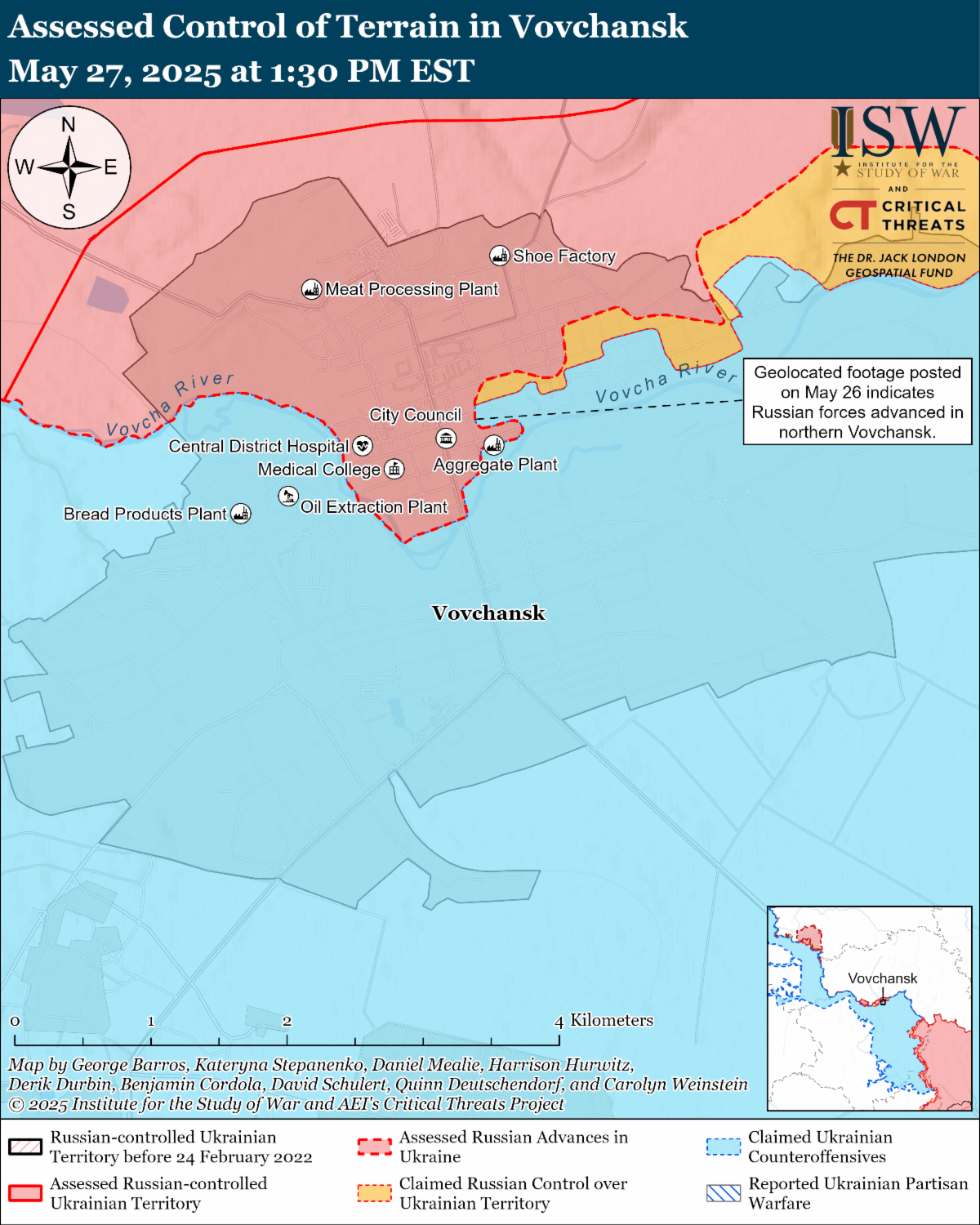The Kremlin is setting conditions to establish permanent control over the Russian-occupied Zaporizhzhia Nuclear Power Plant (ZNPP), suggesting that Russia plans to illegally occupy and annex additional territory in Ukraine. Greenpeace's Ukraine service reported on May 27 that satellite imagery from early February 2025 to May 23, 2025, shows that Russia has laid 90 kilometers of powerlines near the Sea of Azov in occupied Donetsk and Zaporizhia oblasts. Greenpeace reported that these new powerlines are the first observed indications that Russia is acting upon its long-held plans to connect the ZNPP to the Russian power grid. Russian state nuclear energy operator Rosatom Head Alexei Likhachev claimed on May 21 that Rosatom had developed a plan to bring the ZNPP to "full capacity," suggesting that Russia intends to bring the ZNPP's reactors out of their current cold shutdown state. Likhachev claimed in May 2024 to agree with the International Atomic Energy Agency's (IAEA) assessment that restarting the ZNPP was currently "impossible" and that the first condition for restarting the ZNPP must be to ensure its security, either with a security guarantee or after the frontline had shifted away from the ZNPP.
US President Donald Trump's April 2025 seven-point peace proposal to Ukraine included a provision for Ukraine to regain control over the ZNPP with US involvement, and the proposed Ukraine-European peace plan also contained this provision. Russian officials have repeatedly rejected giving up control over the ZNPP, however. Russian officials have also increased their rhetoric, invoking Russia's alleged historical ties to "Novorossiya," which Russian officials have defined as all of eastern and southern Ukraine, and Russian occupation authorities have recently called for Russia to control areas of Dnipropetrovsk Oblast near the Dnipro River that Russia has not yet illegally annexed. The Russian definition of Novorossiya notably includes the area directly across from the ZNPP on the west (right) bank of the Dnipro River. Russia's efforts to connect the ZNPP to the Russian power grid suggest that Russia wants to maintain its control over the ZNPP and operate it safely as Russia likely expects to significantly push the frontline away from the plant or plans to occupy and annex Dnipropetrovsk Oblast.
Russian officials are likely leveraging the fact that Ukraine and Russia set no concrete deadlines for the next steps in the peace process in order to delay the process altogether and prolong the war. US Special Envoy to Ukraine General Keith Kellogg told Fox News on May 27 that the United States had received Ukraine’s list of conditions and timelines for a potential peace treaty and is now waiting for Russia to submit its version to begin reconciling the two countries’ positions. Russian Presidential Aide Vladimir Medinsky stated after the May 16 Ukrainian-Russian talks in Istanbul that the two delegations agreed to "write...down in detail" and present their versions for a possible future ceasefire, but did not specify a deadline. Russian Ministry of Foreign Affairs (MFA) Spokesperson Maria Zakharova claimed on May 27 that Russia is preparing its version of the memorandum. Russian Minister of Foreign Affairs Sergei Lavrov stated on May 27 that the success of peace negotiations will depend on the participants’ willingness to address the war’s ”root causes,” reiterating long-standing Russian demands that amount to full Ukrainian capitulation. The Kremlin is likely leveraging the lack of a deadline to prolong negotiations in an attempt to extract more concessions and improve Russia’s negotiating position by making battlefield advances.
Key Takeaways:
- The Kremlin is setting conditions to establish permanent control over the Russian-occupied Nuclear Power Plant (ZNPP), suggesting that Russia plans to illegally occupy and annex additional territory in Ukraine.
- Russian officials are likely leveraging the fact that Ukraine and Russia set no concrete deadlines for the next steps in the peace process in order to delay the process altogether and prolong the war.
- Putin continues to use orchestrated public engagements to forward the Kremlin's effort to create a militarized Russian society united against the West that supports a prolonged war in Ukraine and possible future conflict with NATO.
- The European Union (EU) Council approved the first phase of the European Commission’s ReArm Europe/Readiness 2030 plan.
- Ukraine's Western allies continue to provide military aid to Ukraine.
- Ukrainian forces recently advanced near Chasiv Yar. Russian forces recently advanced near Vovchansk, Kupyansk, and Pokrovsk.
| 




 [ISW] 이란 업데이트, 2025년 5월 27일
[ISW] 이란 업데이트, 2025년 5월 27일
 [ISW] 러시아의 공세 캠페인 평가, 2025년 5월 26일
[ISW] 러시아의 공세 캠페인 평가, 2025년 5월 26일